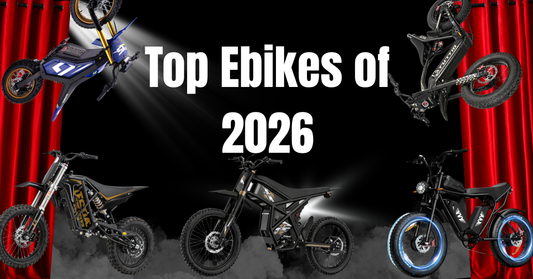Why an E-Bike Classification Guide Matters
Electric bikes are rapidly transforming urban transportation and recreational riding. With more models entering the market every year, it’s easy to feel overwhelmed by legal categories, speed limits, pedal assist technology, and local trail access rules. To clear the confusion, this E-bike classification guide will break down the three main e-bike classes, explain how they differ, and highlight where you can ride them legally. We’ll also discuss the Z8 e-bike, which is street-legal and classified as a Class 3 electric bike, with a top speed of 28 mph.
Whether you’re commuting to work, enjoying weekend trail rides, or simply exploring your neighbourhood, understanding proper e-bike classifications ensures you’ll stay compliant with the law while getting the best experience from your ride.
What Is E-Bike Classification?
The concept of e-bike classification was introduced to bring clarity to how different electric bikes interact with traffic laws, road safety standards, and urban planning policies. Without classifications, an e-bike capable of 20 mph could be treated the same as a high-powered machine exceeding 30 mph, which isn’t safe or practical.
The E-bike classification guide system divides e-bikes into three categories (Class 1, Class 2, and Class 3) based primarily on speed capabilities and whether or not the bike uses a throttle. These factors directly impact where e-bikes are allowed to operate, ranging from bike paths to city streets.
Class 1: Pedal Assist Only Up to 20 MPH
Class 1 e-bikes are the most beginner-friendly category. They operate with a motor that kicks in only when you pedal, providing a "pedal assist" boost without exceeding 20 mph. This ensures a natural riding experience that feels close to traditional cycling, but with the added benefit of electronic support.
Local laws often allow Class 1 bikes on shared-use paths, bike lanes, and trails where motorized vehicles are otherwise banned. However, rules vary depending on city ordinances and state regulations, so always confirm your rights before riding.
One advantage of Class 1 e-bikes is their accessibility to riders who want steady assistance without high speed. They’re ideal for commuting shorter distances, climbing hills, or beginners looking for a smooth entry point into electric cycling.
Class 2: Throttle Assist Up to 20 MPH
Next in the E-bike classification guide, we find Class 2 models. These bikes are unique because they include both pedal assist and throttle operation, allowing riders to accelerate without pedaling. Throttle control is especially valuable for riders with mobility challenges or for situations requiring quick, effortless starts at stoplights.
Even though Class 2 e-bikes also cap speeds at 20 mph, their throttle capability sometimes sparks debates about access to trails and shared paths. Certain jurisdictions restrict throttle use entirely, while others lump Class 2 bikes with Class 1 rules.
Before purchasing or riding a Class 2 electric bike, check local laws to ensure throttle functionality does not limit where you can safely operate your e-bike.
Class 3: Pedal Assist Up to 28 MPH
Class 3 e-bikes are the speed champions in the E-bike classification guide. These models can reach speeds up to 28 mph, but they rely on pedal assist only—no throttle functionality is permitted. Class 3 bikes are designed for commuters who want to keep up with urban traffic while avoiding car congestion.
Class 3 restrictions vary widely. In most cases, helmets are mandatory, and riders must be at least 16 years old. Some states disallow Class 3 e-bikes from bike paths, reserving them strictly for roads and lanes. That’s why always consulting your state or city’s e-bike laws is critical before hitting the road.
The Z8: A Street Legal Class 3 E-Bike
When discussing high-performance, street-ready models, the Z8 deserves special mention. Classified as a Class 3 electric bike, the Z8 reaches a top speed of 28 mph using pedal assist, making it fully street legal in most jurisdictions.
What sets the Z8 apart is its balance between speed and compliance. Unlike mopeds or scooters, the Z8 does not need special licensing or registration in many areas, provided it respects the Class 3 limitations. Riders benefit from a sustainable, fast, and efficient commuting option while staying legally protected.
However, it’s essential to verify your local regulations. Some states add extra equipment requirements like mirrors, front and rear lights, or specific braking systems for Class 3 e-bikes. Staying informed ensures your Z8 or any comparable Class 3 bike remains compliant and safe.
Other Models and Street-Legal Speed Limits
While the Z8 is a clear Class 3 bike at 28 mph, other e-bike models fall into lower classes but may still qualify as street legal depending on their speed limits. For instance, many Class 1 and Class 2 bikes cap out at 20 mph, which allows them to qualify as street legal under certain jurisdictions.
The challenge lies in varying regional laws. Some areas allow Class 2 throttle-based bikes on city streets, while others limit them to shared-use paths. The takeaway here is to research your local rules before assuming your e-bike qualifies.
Tip: Contact your local Department of Transportation to confirm e-bike classification rules in your region.
Why Local Regulations Matter
One of the most important lessons in this e-bike classification guide is that the same bike may have completely different legal access depending on where you ride it. Federal standards in the U.S. define basic power and speed limits, but state and local governments add additional restrictions on trail access, helmet use, minimum age requirements, and licensing.
For example:
- California explicitly recognizes all three classes and restricts Class 3 bikes from certain bike paths.
- New York allows throttle-based e-bikes but limits their speeds depending on class.
- Some smaller municipalities ban throttle use altogether on natural-surface trails.
These nuances demonstrate why riders shouldn’t rely solely on manufacturer claims about legality. Instead, they should consult city codes and trail authorities.
Ride Smart, Ride Legal
This e-bike classification guide demonstrates why understanding Class 1, Class 2, and Class 3 categories is essential for safe and legal riding. The Z8 stands out as a top-performing Class 3 model, hitting 28 mph while maintaining street-legal status. Other e-bikes may qualify for street use based on their speed limits, but local regulations always dictate the final answer.
By mastering these classifications and confirming your city or state’s rules, you’ll enjoy the freedom of electric biking without legal hurdles. Whether you’re after a leisurely trail ride or a fast-paced commute, the right e-bike and compliance knowledge ensure your journey stays smooth.
If you’re curious about e-bike model comparisons, you can browse our Riding Times e-bike website for in-depth breakdowns.
For legal details and state-specific rules, visit the official PeopleForBikes State-by-State Electric Bike Laws, a trusted legal advocacy source for riders.
If you want additional safety information, see the Helmet Laws for Electric Bikes for clear summaries on helmet use and state-by-state requirements.
To understand wider electric mobility regulations, explore Electric Bicycle Laws – Wikipedia for an overview that includes international comparisons.


